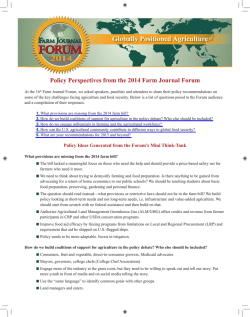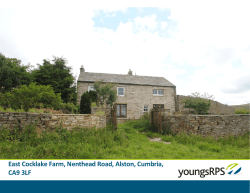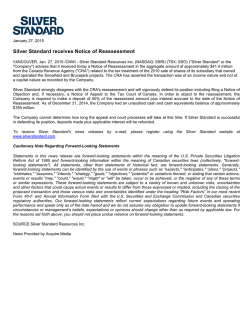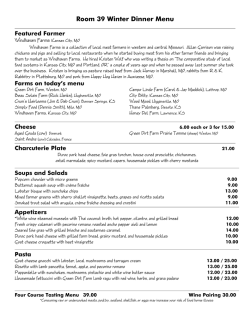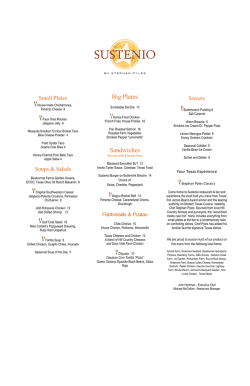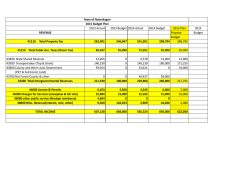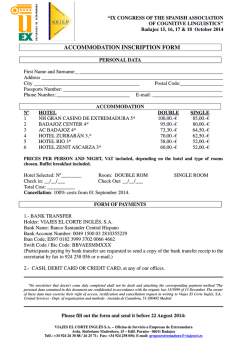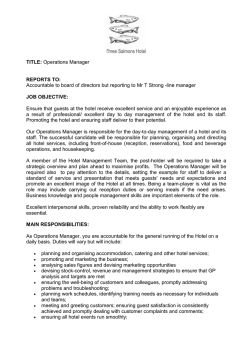
Farmland Investing via the Public Markets
Company Overview January 2015 Forward-Looking Statements Some of the statements contained in this presentation constitute forward-looking statements within the meaning of the federal securities laws. Forward-looking statements relate to expectations, beliefs, projections, future plans and strategies, anticipated events or trends and similar expressions concerning matters that are not historical facts. In some cases, you can identify forward-looking statements by the use of forward-looking terminology such as “may,” “will,” “should,” “expects,” “intends,” “plans,” “anticipates,” “believes,” “estimates,” “projects,” “predicts,” or “potential” or the negative of these words or similar words, which are predictions of or indicate future events or trends and which do not relate solely to historical matters. You can also identify forward-looking statements by discussions of strategy, plans or intentions. The forward-looking statements contained in this presentation reflect our current views about future events and are subject to numerous known and unknown risks, uncertainties, assumptions and changes in circumstances, many of which are beyond our control, that may cause actual results to differ significantly from those expressed in any forward-looking statement. While forward-looking statements reflect our good faith beliefs, assumptions and expectations, they are not guarantees of future performance. Furthermore, we expressly disclaim any obligation to publicly update or revise any forward-looking statement to reflect changes in the underlying assumptions or factors, new information, data or methods, future events or other changes. For a further discussion of these and other factors that could cause our future results to differ significantly from any forward-looking statements, see the section entitled “Risk Factors” in the final prospectus related to our follow-on offering, which was filed with the Securities and Exchange Commission on July 25, 2014, and subsequent filings with the Securities and Exchange Commission. This presentation contains statistics and other data that has been obtained from or compiled from information made available by third parties. We have not independently verified such statistics or data. 2 Company Overview – Growth Story At the time of the IPO (April 2014), Farmland Partners owned 7,323 acres and currently owns or has under contract a total of 48,680 acres1 located in the following regions: o Corn Belt: 7,480 acres o Plains: 21,231 acres o Delta: 13,151 acres o Southeast: 6,818 acres Total weighted-average Cap Rate of approximately 4.54%2 Weighted-average Cap Rate of post-IPO acquisitions of approximately 5.01%2 Total of 35 tenants2 Preliminary capital structure details as of December 31, 2014 (unaudited)3 o Total purchase price of farmland assets of approximately $197.2 million4 o Total debt of $113.9 million o 9,676,755 fully diluted shares outstanding (including OP units and restricted stock) o Market capitalization of $103.9 million5 o Total cash of approximately $33.7 million Dividend Policy o Third quarter dividend of $0.105 per share ($0.42 on an annualized basis) was increased 10.5% to $0.116 ($0.464 on an annualized basis) in the fourth quarter ____________________ (1) Of which 46,441 acres are owned and 2,239 acres are under contract and pending closing (2) Including farms under contract (3) The amounts presented are preliminary and remain subject to adjustment in connection with the audit of the Company’s year-end financial statements (4) Sum of implied purchase price of IPO portfolio (i.e., debt assumed and value of OP units issued) and contractual purchase prices of acquisitions thereafter, which is different than our total real estate assets as of December 31, 2014 (5) Based on January 8, 2015 closing price of $10.74 and fully diluted shares outstanding 3 Management Overview Members of management have a long history of involvement in farmland acquisitions and management Paul Pittman, Executive Chairman, President and Chief Executive Officer Paul grew up in a farm family and has been buying and operating farms on his own account since 1999. In addition to his roles at Farmland Partners, Paul is also an owner of Pittman Hough Farms, LLC. Before devoting full attention to his farming business, Paul was a public company CFO (Jazz Technologies), investment banker (Merrill Lynch, Wasserstein Perella, ThinkEquity) and lawyer (Sullivan & Cromwell). Paul was also founder and CEO of HomeSphere, an enterprise software company. He has a B.S. in Agriculture from the University of Illinois, a MPP from Harvard University, and a J.D. with Honors from the University of Chicago. Luca Fabbri, Chief Financial Officer, Secretary and Treasurer Luca has been active in the agricultural industry for over a decade, first evaluating farmland investments and then in an operating role as Senior VP of American Agriculture Corporation. Luca was also a tech entrepreneur (Co3 Systems and HomeSphere), served as head of corporate development for a public company (Jazz Technologies), worked as a consultant in technology, finance, and corporate development (Elk Creek Ventures), and worked in investment banking (Merrill Lynch). He has a B.S. with Honors in Economics from the University of Naples (Italy) and an M.B.A. in Finance from the Massachusetts Institute of Technology. Wade Harrison, Farm Manager (Southeast, Delta, Texas) Wade has been active in the agricultural industry for over two decades. Before joining Farmland Partners, Wade served as the Row Crop Farm Manager (Chess Ag Full Harvest), General Manager and Partner for the operation, growth, and development of a 5,500 acre farm (South Park Farms Inc.), and General Manager and Chief Member overseeing all activities for a heavy equipment rental / leasing and custom farming business (W.W. Planting, LLC). Wade has a B.A. in Political Science from Rhodes College and an M.A. from the University of Memphis. Ben Palen, Farm Manager (Plains, Southwest, Pacific Northwest) Ben has been involved in the agricultural industry for over 40 years, during which time he has worked on various consulting projects helping to advise companies on identification of acquisitions, structuring of purchase agreements, and development of farmland. Most recently, Ben has been the co-owner and manager of Great Plains Farms, LLC, and has been responsible for evaluation, purchase and operation of farmland and grazing land in the western Great Plains for the family company and investors. Ben also has experience as a lawyer (Milbank, Tweed, Hadley and McCloy) and an investment banker (Merrill Lynch). Ben has a B.S. with Honors from the University of Kansas and J.D. from the Northwestern University School of Law. Jesse Hough, Consultant Jesse grew up on a family farm in Central Nebraska, where he worked throughout high school and college. Jesse currently serves as an owner and the CFO of Pittman Hough Farms, LLC. He was with Kennedy and Coe - a top 100 accounting firm with the main emphasis in agri-business accounting - for 18 years, the last ten of which he served as a member, partner and owner. While at Kennedy and Coe, Jesse was responsible for consulting with large agri-business operations throughout the United States on their financial models and organizational structures. He has a B.S. in Business with an emphasis in Accounting from the University of Nebraska. *Farmland Partners is headquartered in Denver, Colorado 4 Powerful Long-Term Global Supply & Demand Dynamics > 400% in developing world GDP growth in 2060 >38% population growth in 2050 Nearly 30% more in developing world meat consumption per capita in 2030 45.5% Projected Increase in Global Grain Demand by 2050 ____________________ Sources: OECD, World Bank, FAO, U.S. Geological Survey 5 Continued global water depletion 99 million acres of urban conversion (2030) Declining rates of new cropland addition 4.3% Projected Increase in Global Cropland Supply by 2050 Attractive Investment Characteristics Yield and crop optionality differentiate farmland from individual agricultural commodity investments Since 1991, farmland has offered consistently positive annual returns and lower volatility, leading to significant cumulative outperformance Farmland Cumulative Returns vs. Corn & Soybeans (1991 = 100) Farmland Corn Soybeans 1,400 1,200 1,000 800 (1) 600 400 200 0 1991 1992 1993 1994 1995 1996 1997 1998 1999 2000 2001 2002 2003 2004 2005 2006 2007 2008 2009 2010 2011 2012 2013 2014 Farmland Annual Returns vs. Corn & Soybeans (non-cumulative) 150% Farmland Corn Soybeans 75% 0% (1) (75%) 1992 1993 1994 1995 1996 1997 1998 1999 2000 2001 2002 2003 2004 2005 2006 2007 2008 2009 2010 2011 2012 2013 2014 ____________________ Sources: NCREIF, SNL Financial, FactSET and Economic Research Service/USDA 5 Attractive Investment Characteristics Farmland properties have regularly outperformed other real estate asset classes Since NCREIF began tracking farmland values in 1992, there has not been a year with negative total returns Since 2003, farmland has yielded total returns of 16.2% 2003 2004 2005 2006 2007 2008 2009 2010 2011 2012 2013 2014 S&P 500 26.4% Retail 23.0% Farm 33.9% Hotel 23.6% Office 20.5% Farm 15.8% S&P 500 23.5% Apartment 18.2% Apartment 15.5% Farm 18.6% S&P 500 29.6% Retail 13.6% Retail 17.1% Farm 20.5% Apartment 21.2% Farm 21.2% Timber 18.4% Timber 9.5% Farm 6.3% Retail 12.8% Farm 15.2% S&P 500 13.4% Farm 20.9% Industrial 12.3% Farm 9.7% Apartment 13.0% Industrial 20.3% Office 19.1% Hotel 18.1% Retail (4.1%) Timber (4.8%) S&P 500 12.8% Industrial 14.6% Retail 11.6% Retail 12.9% S&P 500 11.4% Apartment 8.9% Industrial 12.1% Retail 20.0% Industrial 17.0% Farm 15.9% Industrial (5.8%) Retail (10.9%) Office 11.7% Retail 13.8% Apartment 11.2% Industrial 12.3% Apartment 10.4% Industrial 8.2% Office 12.0% Office 19.5% Apartment 14.6% Industrial 14.9% Apartment (7.3%) Apartment (17.5%) Industrial 9.4% Office 13.8% Industrial 10.7% Apartment 10.4% Office 9.8% Timber 7.7% Timber 11.2% Timber 19.3% Timber 13.7% Retail 13.5% Office (7.3%) Industrial (17.9%) Hotel 9.0% Hotel 11.8% Office 9.5% Office 9.9% Hotel 8.6% Hotel 6.1% Hotel 10.2% Hotel 19.0% S&P 500 13.6% Apartment 11.4% Hotel (9.4%) Office (19.1%) Farm 8.8% Timber 1.6% Hotel 8.3% Timber 9.7% Farm 7.6% Office 5.7% S&P 500 9.0% S&P 500 3.0% Retail 13.3% S&P 500 3.5% S&P 500 (38.5%) Hotel (20.4%) Timber (0.2%) S&P 500 (0.0%) Timber 7.8% Hotel 7.7% Timber 5.6% ____________________ Source: National Council of Real Estate Investment Fiduciaries 6 Attractive Investment Characteristics Price Appreciation + Current Yields = Powerful Total Returns Story Average Annual Returns and Standard Deviation: Farmland vs. Select Asset Classes (1995 – 2014) Annualized Returns Standard Deviation 25.0% 20.0% 19.9% 20.0% 15.6% 15.0% 12.4% 11.3% 9.8% 10.0% 9.6% 8.2% 7.3% 8.1% 7.8% 7.0% 6.4% 5.8% 5.0% Farmland (1) Total REIT Return (2) ____________________ Sources: (1) NCREIF (2014) (2) Bloomberg. Annual returns of the MCSI US REIT INDEX (RMS) (3) Bloomberg. S&P 500 returns include dividends (4) The BofA Merrill Lynch US Corporate Index (C0A0) (5) Bloomberg 8 Apartments (1) All Commercial Real Estate (1) S&P 500 (3) Investment Grade Bonds (4) Gold (5) Attractive Investment Characteristics Global Fundamentals Vs. Real Estate Alternatives: 9 Capital Markets Opportunity Operating Environment Vs. Commodity Near-zero Vacancy Alternatives: Up-front Rent Current Yield Little or no Maintenance Capex or Property Taxes Crop Optionality Productivity Gains Long-term Drivers Supply Constraints No Obsolescence No Economic Depreciation Farmland Price Trends: Perception vs. Reality Contrary to speculative negative reports by the press, farmland values are still increasing in most of the United States according to the USDA and the Federal Reserve As reported by the USDA, the United States farm real estate value was up 8.1% from 2013 values 1 o Illinois: +5.9% o Nebraska: +11.4% o Arkansas: +5.6% o Louisiana: +4.7% o Colorado: +5.5% Federal Reserve surveys in the primary agricultural regions also highlighted generally an increase in farmland value per acre from 2Q 2013 to 2Q 2014: o Chicago Fed: +3%2 o Kansas City Fed: +6%3 o St. Louis Fed: -3.5%4 o Dallas Fed: +4.9% dryland and +1.8% irrigated5 Recently released third quarter Federal Reserve surveys also reflected the upward trend in farmland value, with percentage increases from 3Q 2013 to 3Q 2014 as follows: o Chicago Fed: 0%2 o Kansas City Fed: +1% dryland and +2% irrigated3 o St. Louis Fed: +14.8%4 o Dallas Fed: +9.2% dryland and +4.6% irrigated5 ____________________ Sources: (1) USDA, Agricultural Land Values Report (August 2014) (2) Chicago Fed, AgLetter (3) Kansas City Fed, Agricultural Credit Conditions (4) St. Louis Fed, Agricultural Finance Monitor (5) Dallas Fed, Agricultural Survey, Northern Louisiana 10
© Copyright 2025
